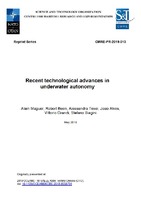| dc.contributor.author | Maguer, Alain | |
| dc.contributor.author | Been, Robert | |
| dc.contributor.author | Tesei, Alessandra | |
| dc.contributor.author | Alves, João | |
| dc.contributor.author | Grandi, Vittorio | |
| dc.contributor.author | Biagini, Stefano | |
| dc.date.accessioned | 2019-06-14T13:44:22Z | |
| dc.date.available | 2019-06-14T13:44:22Z | |
| dc.date.issued | 2019/05 | |
| dc.identifier.govdoc | CMRE-PR-2019-013 | en_US |
| dc.identifier.uri | http://hdl.handle.net/20.500.12489/754 | |
| dc.description.abstract | Underwater Unmanned systems (or more precisely systems of systems) will definitely play an important role in future maritime surveillance and environmental data collection. For many years, the NATO Centre for Maritime Research and Experimentation (CMRE) has deeply invested in developing Artificial Intelligence algorithms to allow robots to perform unmanned missions. These scientific efforts have always been based on these robots? capability to localize themselves, to communicate reliably, and to continuously operate for many days or even weeks or months. This paper describes the recent technological advances performed at CMRE for solving these challenges, in particular the work done on increased persistence, deep-water navigation, communication and launch and recovery. | en_US |
| dc.format | 8 p. : ill. ; digital, PDF file | |
| dc.language.iso | en | en_US |
| dc.source | In: 2018 OCEANS - MTS/IEEE Kobe Techno-Oceans (OTO), doi: 10.1109/OCEANSKOBE.2018.8558791 | en_US |
| dc.subject | Unmanned Underwater Vehicles (UUV) | en_US |
| dc.subject | Navigation and positioning systems | en_US |
| dc.subject | Deep water | en_US |
| dc.subject | Underwater communications | en_US |
| dc.subject | Launch and recovery systems | en_US |
| dc.title | Recent technological advances in underwater autonomy | en_US |
| dc.type | Reprint (PR) | en_US |
| dc.type | Papers and Articles | en_US |
